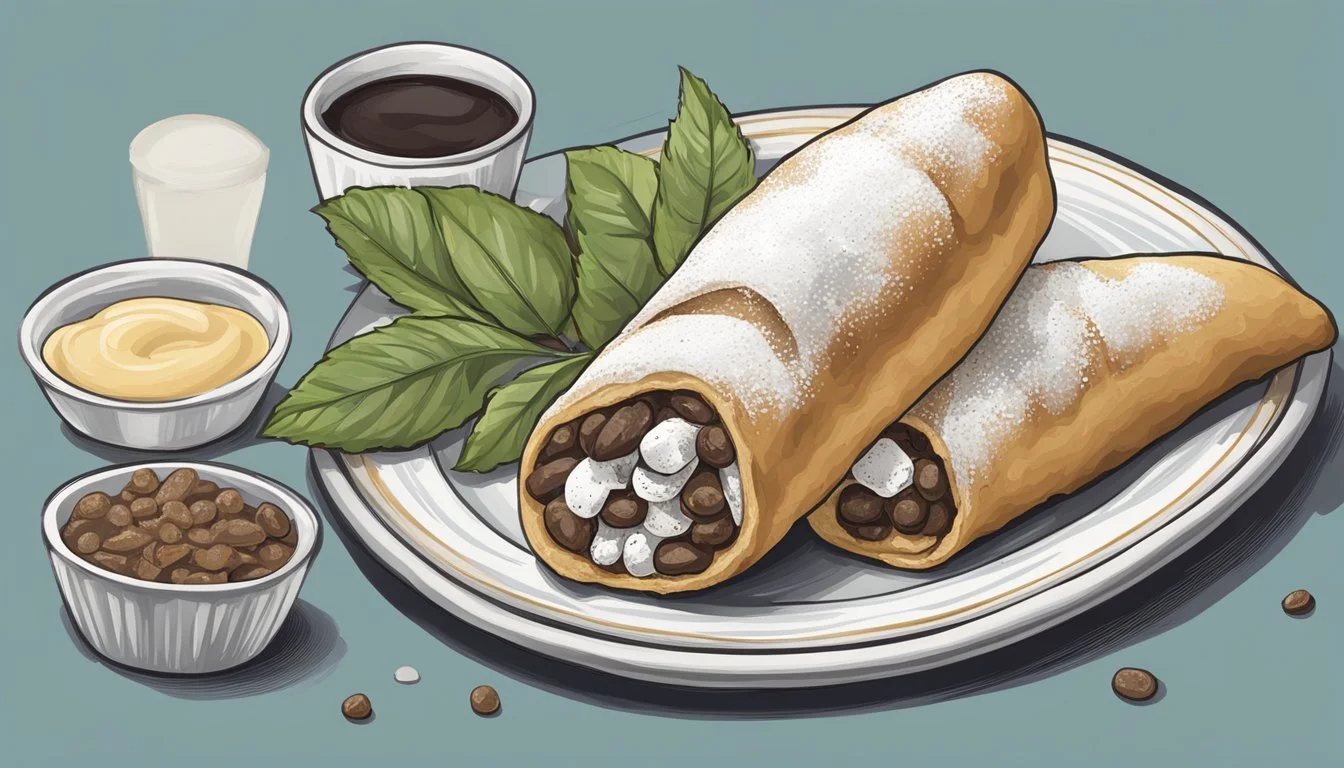Are Cannoli Gluten-Free?
Understanding Their Ingredients and Alternatives
Cannoli, a classic Italian dessert beloved for its crispy shells and sweet, rich filling, traditionally contains gluten. The primary reason is that the pastry dough, which forms the characteristic tube-shaped shells, is typically made from wheat flour, a source of gluten. This presents a challenge for those who either have celiac disease or follow a gluten-free diet for other health reasons, as consuming gluten can lead to adverse reactions ranging from discomfort to serious intestinal damage in sensitive individuals.
However, the culinary landscape is ever-evolving, and the demand for gluten-free options has ushered in innovative recipes that replace wheat flour with gluten-free alternatives. These recipes often use a blend of gluten-free flours such as rice flour or a mix which may include other starches and grains like brown rice flour, cassava flour, or almond meal to mimic the texture and taste of traditional cannoli shells.
While the filling of a cannoli typically includes gluten-free ingredients such as ricotta cheese, sugar, and sometimes chocolate chips or candied fruit, ensuring that the entire dessert is gluten-free requires careful consideration of all components. Many bakeries and recipes now offer gluten-free cannoli that promise to deliver the same satisfying crunch and creamy sweetness without the gluten, making it a safe and delightful option for those avoiding this particular protein.
Understanding Cannoli
Cannolis are a staple of Italian pastry, known for their distinctive tube shape and creamy filling. This section dives into the origins of cannolis and the classic elements that constitute this beloved dessert.
Historical Background
Cannolis originated in Sicily, Italy, and are steeped in a rich history that dates back to the times of Arab rule over the island. They became a symbol of festivity, often made to celebrate Carnivale, the festival leading up to Lent. Their popularity has since spread, becoming a feature in Italian bakeries and beyond.
Traditional Cannoli Components
The traditional cannoli consists of a crispy shell and a sweet, creamy filling. The shell is made from a dough comprising wheat flour, sugar, and egg as binding agents, which is then deep-fried to achieve a golden-brown finish. Commonly, the filling is a mixture of ricotta cheese, often sweetened with sugar and flavored with ingredients like chocolate chips or candied fruit. Variations exist, but these components are the heart of any classic cannoli recipe.
Gluten-Free Cannoli Basics
Gluten-free cannoli offers a delightful alternative to the traditional dessert, allowing those with gluten sensitivities to indulge. The transformation of cannoli into a gluten-free treat hinges on specific ingredients and preparation methods.
What Makes Cannoli Gluten-Free?
Cannoli become gluten-free when the flour typically used in the shell is replaced with a gluten-free alternative. The absence of wheat, barley, rye, or any cross-contaminated oats ensures the cannoli shells do not contain gluten. This precaution is essential for individuals with celiac disease or gluten intolerance. Gluten-free flours might include combinations of rice flour, brown rice flour, cassava flour, and potentially other non-gluten grains or even nut flours to replicate the structure and taste that traditional flour provides.
Key Ingredients for Gluten-Free Cannoli
Gluten-Free Flour Blend: A base of white rice flour may be blended with brown rice flour and cassava flour. Additional ingredients like ground golden flax seeds may be added for texture and consistency.
Binding Agents: Without gluten to hold the dough together, alternatives like xanthan gum or ground flax seeds are used. These ingredients aid in making the dough pliable and workable.
Fats: To create the classic flaky texture of cannoli shells, fats like butter or oil are utilized. They must be evenly incorporated into the flour blend.
Liquid: Wine, often used in traditional cannoli dough, can also be incorporated into gluten-free recipes, serving as a liquid component that hydrates the dough.
By selecting the right combination of gluten-free flours and other ingredients, bakers can create a cannoli shell that rivals its traditional counterpart in both taste and texture.
Ingredients Analysis
The quality and combination of ingredients are crucial when adapting traditional cannoli recipes to be gluten-free. Attention to the components of flours, fillings, and potential healthy substitutes defines the success of creating a delicious gluten-free cannoli.
Flours Used in Gluten-Free Cannoli
Traditionally, cannoli shells are crafted from wheat flour, which contains gluten. For a gluten-free version, rice flour and various starches such as potato or tapioca serve as adequate substitutes to mimic the structure that gluten provides. The addition of xanthan gum is often necessary in gluten-free baking to add viscosity and elasticity to the dough. Here's a common blend in a tabular format that can be used for the cannoli shells:
Flour/Starch Quantity Rice Flour 1 cup Potato Starch 1/4 cup Tapioca Starch 1/4 cup Xanthan Gum 1 teaspoon
Choosing the Right Filling
The filling in cannoli typically relies on ricotta cheese, which is naturally gluten-free. To maintain the authentic taste and texture, choose high-quality, whole milk ricotta and strain it to remove excess moisture. This cheese can be enhanced with additions such as mini chocolate chips or crushed pistachios for texture and flavor. Some recipes might also include a splash of sweet Marsala wine to enrich the filling.
Healthy Alternatives
Those seeking healthier versions of gluten-free cannoli might look for alternatives to reduce sugars and fats without compromising the dessert's integrity. Using part-skim ricotta can cut down on fat, while utilizing dark chocolate with higher cocoa content might provide antioxidant benefits with less sugar content. Additionally, incorporating nuts like pistachios offers beneficial fats, proteins, and a satisfying crunch.
Preparation Techniques
To ensure gluten-free cannoli that taste just as delightful as traditional ones, the preparation techniques are adjusted to cater to the specific nature of gluten-free ingredients. Attention to detail in creating the dough, shaping and frying the shells, and assembling the cannoli is paramount.
Creating the Dough
For the dough, one starts by mixing gluten-free flours such as white rice, brown rice, and cassava flour, often combined with a binding agent like xanthan gum to replicate the elasticity gluten provides. Some recipes might also include ground golden flax seeds to help bind the dough. Once the dry ingredients are mixed, wet ingredients like oil and sometimes a small quantity of a liquid such as vinegar or coconut milk are incorporated to form the dough. The dough should be kneaded until smooth and then allowed to rest, covered, to prevent it from drying out.
Shaping and Frying the Shells
The rested dough is then divided, with half kept covered while the other is rolled out. The goal is to roll the dough as thinly as possible, typically aiming for a thickness of about 4 millimeters. Using a round cutter, circles are cut out for shaping around cannoli forms. The shells are then either fried or baked; frying in oil allows them to puff up and become crispy, while baking is a lighter alternative. When frying, one must carefully monitor the oil temperature to ensure even cooking, while baking requires preheating the oven to the appropriate temperature and often involves spraying the shells with cooking spray before baking to achieve a golden color.
Assembling the Cannoli
Once the shells are golden and have cooled, they are carefully slid off the cannoli forms. They should be filled with a dairy-free ricotta filling or a traditional ricotta filling just before serving to maintain their crispness. The filling is piped into each shell from both ends to ensure the whole shell is filled, and the ends can be dipped in chocolate chips, pistachios, or powdered sugar for an added touch of flavor and decoration.
Customizing Your Cannoli
Creating a personalized cannoli involves choosing unique fillings and decorative touches that cater to individual tastes and dietary needs. The options for customization are plentiful, allowing for a range of flavors and textures.
Variations in Fillings
The traditional ricotta filling of a cannoli can be tailored to include a variety of mix-ins or substitutions. For Gluten-Free needs, it is crucial to ensure that all added ingredients do not contain gluten.
Chocolate Chips: Mini chocolate chips can be folded into the ricotta filling for a classic flavor addition.
Dried Fruit: Chopped dried fruits like apricots or figs offer a natural sweetness and chewy texture.
Nuts: Finely chopped nuts such as pistachios or almonds provide a pleasant crunch and rich flavor.
Decorations and Garnishes
Adding ornamental features not only enhances the appearance but also allows the flavors to be intensified or complemented.
Powdered Sugar: A dusting of powdered sugar gives a subtle sweetness and a professional finish.
Garnish Options:
Chocolate Drizzle: A drizzle of melted chocolate can be used to add visual appeal and an extra chocolatey dimension.
Crushed Nuts: Sprinkling crushed pistachios or other nuts on the ends or along the sides of the cannoli adds color and texture.
Candied Zest: Citrus zest, candied for added sweetness, can provide a burst of flavor and a spark of color.
Each element introduced to the cannoli should be carefully selected to ensure it aligns with the desired outcome; a harmonious blend of tastes and textures that simultaneously respects the integrity of the gluten-free requirement.
Tips and Tricks
When making gluten-free cannolis, the right techniques can make all the difference. Here are some tips and tricks for achieving the perfect texture and ensuring your cannolis are stored and served at their best.
Achieving the Perfect Texture
For the ideal shell texture, they should start with rolling out the dough evenly and as thinly as possible. A thin dough ensures a more delightful crunch when bitten into. When wrapping the dough around the cannoli tube, one should make sure not to wrap it too tightly, as it needs to be easily removed after cooking without breaking the delicate shell.
Rolling Dough: Aim for a thickness of around 4mm for the perfect balance between sturdiness and crispiness.
Cannoli Tubes: Use non-stick cannoli tubes and seal the dough around the tube with egg whites or another gluten-free binder to prevent unwrapping during cooking.
Cook Time: After wrapping, they should fry or bake the shells until golden brown, usually taking about 10 minutes in a preheated oven at 410°F (210°C) or in an air fryer at 400°F.
Cooking sprays are beneficial for preventing any unwanted dough sticking, whether they are applying it to the tubes before wrapping the dough or to the air fryer basket to facilitate easy removal of the shells.
Storing and Serving
A freshly filled cannolo is the pinnacle of texture and flavor. However, the shells may be prepared in advance. To store the baked cannoli shells, individuals should place them in an airtight container at room temperature. Shells should not be refrigerated, as this can lead to sogginess.
Storage: Keep unfilled shells in an airtight container lined with paper towels to absorb any excess moisture.
Filling: Use a pastry bag for a neater and more efficient filling process. Fill the shells just before serving to maintain crispness.
Serving: Place filled cannolis on a wire rack to allow any excess filling to drip off and keep the shell from getting soggy.
By utilizing these tips, bakers will handle and present their gluten-free cannolis like a professional, allowing the subtleties of their effort to shine through in both flavor and presentation.
Nutritional Information
In evaluating the nutritional profile of cannoli, particularly gluten-free variants, it's essential to focus on their caloric content and allergen considerations. This section provides insights into the energy each serving may offer and outlines the primary dietary allergens present or absent in gluten-free cannoli.
Caloric Content Overview
Gluten-Free Cannoli typically varies in caloric content based on the ingredients used. On average, a single gluten-free cannoli shell may contain:
Without Filling: 100-150 calories
With Ricotta Filling: 250-300 calories (varies with additional ingredients like chocolate chips, nuts, etc.)
These figures are approximate and can differ according to the recipe and size of the cannoli.
Allergen and Dietary Considerations
Gluten-free cannoli aim to eliminate gluten, a protein composite found in wheat and several other grains, which is a common allergen and a concern for individuals with celiac disease or gluten sensitivity.
Common Allergens Present in Gluten-Free Cannoli May Include:
Eggs
Dairy (from ricotta or similar cheese fillings)
Nuts (if used in the filling or embellishments)
For those seeking a plant-based option, gluten-free cannoli can be adapted using plant-based cheeses and egg substitutes. However, individuals with specific dietary restrictions should always verify the ingredients used in each recipe to ensure they align with their dietary needs.
FAQs on Gluten-Free Cannoli
When exploring the world of gluten-free desserts (What wine goes well with desserts?), cannoli often come into question. Making gluten-free cannoli achievable at home is a delicious reality, but clarity is required on whether all cannoli are gluten-free and the available options for both homemade and store-bought varieties.
Common Questions Answered
Are cannoli gluten-free?
Traditionally, cannoli shells are not gluten-free as they contain wheat flour. However, many recipes and some commercial products now offer gluten-free versions.
Can I find gluten-free cannoli shells in stores?
Yes, gluten-free cannoli shells can sometimes be found in stores that specialize in gluten-free products. It's essential to check the labels for gluten-free certification.
Is it possible to make gluten-free cannoli at home?
Absolutely. Home cooks can prepare gluten-free cannoli shells using alternative flours like rice or almond flour mixed with binders such as xanthan gum to ensure the dough holds together.
Can gluten-free cannoli be baked instead of fried?
Gluten-free cannoli shells can be baked as a healthier alternative to frying. Baking often involves preheating the oven to around 410 F and using a gluten-free dough rolled thinly.
Are there vegan and gluten-free cannoli options?
Yes, recipes can be adapted to cater to both gluten-free and vegan diets by substituting dairy and egg components with plant-based alternatives and using gluten-free flours for the shell.
How do I ensure the shells don't contain gluten?
For homemade: Carefully select gluten-free flour and check that all other ingredients, including cooking spray and fillings, are certified gluten-free.
For store-bought: Look for a gluten-free label or certification and review all ingredients on the packaging to avoid cross-contamination risks.
When crafting or buying gluten-free cannoli, being mindful of ingredients and cross-contamination is key. With attention to detail, gluten-free and even vegan cannoli can be a delectable treat that adheres to dietary restrictions without compromising on taste.







